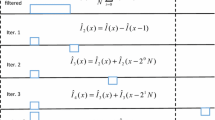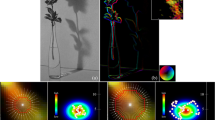Abstract
Machine design of a signal or image operator involves estimating the optimal filter from sample data. The optimal filter is the best filter, relative to the error measure used; however, owing to design error, the designed filter might not perform well. In general it is suboptimal. The envelope constraint involves using two humanly designed filters that form a lower and upper bound for the designed operator. The method has been employed for binary operators. This paper considers envelope design for gray-scale filters, in particular, aperture filters. Some basic theoretical properties are stated, including optimality of the design method relative to the constraint imposed by the envelope. Examples are given for noise reduction and de-blurring.
Similar content being viewed by others
References
J. Barrera, E.R. Dougherty, and N.S. Tomita, “Automatic programming of binary morphological machines by design of statistically optimal operators in the context of computational learning theory,” Electronic Imaging, Vol. 6, No. 1, pp. 54–67, 1997.
J. Barrera, E.R. Dougherty, and M. Brun, “Hybrid humanmachine binary morphological operator design. An independent constraint approach,” Signal Processing, Vol. 80, No. 8, pp. 1469–1487, 2000.
J. Barrera, R. Terada, R. Hirata Jr., and N.S.T. Hirata, “Automatic programming of morphological machines by PAC learning,” Fundamenta Informaticae, Vol. 41, Nos. 1/2, pp. 229–258, 2000.
C.M. Bishop, Neural Networks for Pattern Recognition, Oxford: Clarendon, 1996.
C. Burges, “A tutorial on support vector machines for pattern recognition,” Data Mining and Knowledge Discovery, Vol. 2, pp. 121–167, 1998.
E.J. Coyle and J.-H. Lin, “Stack filters and the mean absolute error criterion,” IEEE Transactions on Acoustics, Speech and Signal Processing, Vol. 36, No. 8, pp. 1244–1254, 1988.
E.R. Dougherty, Random Processes for Image and Signal Processing, SPIE and IEEE Presses: Bellingham, 1999.
E.R. Dougherty and J. Barrera, “Bayesian design of optimal morphological operators based on prior distributions for conditional probabilities,” Acta Stereologica, Vol. 16, No. 3, pp. 167–174, 1997.
E.R. Dougherty and J. Barrera, “Pattern recognition theory in nonlinear signal processing,” Mathematical Imaging and Vision, Vol. 16, No. 3, pp. 181–197, 2002.
E.R. Dougherty, J. Barrera, G. Mozelle, S. Kim, and M. Brun, “Multiresolution analysis for optimal binary filters,” Mathematical Imaging and Vision, Vol. 14, pp. 53–72, 2001. 96 Brun et al.
E.R. Dougherty and R.P. Loce, “Precision of morphologicalrepresentation estimators for translation-invariant binary filters: Increasing and nonincreasing,” Signal Processing, Vol. 40, pp. 129–154, 1994.
M. Gabbouj and E.J. Coyle, “Minimum mean absolute error stack filtering with structural constraints and goals,” IEEE Transactions on Acoustics, Speech and Signal Processing,Vol. 38, No. 6, pp. 955–968, 1990.
N.R. Harvey and S. Marshall, “The use of genetic algorithms in morphological filter design,” S ignal Processing: Image Communication, Vol. 8, No. 1, pp. 55–71, 1996.
N.S.T. Hirata, J. Barrera, and E.R. Dougherty, “Design of statistically optimal stack filters,” in Proc. of Sibgrapi'99, J. Stolfi and C.L. Tozzi (Eds.), Campinas, SP, Brazil, 1999, pp. 265–274
N.S.T. Hirata, E.R. Dougherty, and J. Barrera, “A switching algorithm for design of optimal increasing binary filters over large windows,” Pattern Recognition, Vol. 33, No. 6, pp. 1059–1081, 2000.
R. Hirata Jr., E.R. Dougherty, and J. Barrera, “Aperture filters,” Signal Processing, Vol. 80, No. 4, 697–721, 2000.
N.S.T. Hirata, E.R. Dougherty, and J. Barrera, “Iterative design of morphological binary image operators,” Optical Engineering, Vol. 39, No. 12, pp. 3106–3123, 2000.
P. Kraft, N.R. Harvey, and S. Marshall, “Parallel genetic algorithms in the optimization of morphological filters: A general design tool,” Electronic Imaging, Vol. 4, No. 6, pp. 504–516, 1997.
P. Kuosmanen and J.T. Astola, “Optimal stack filters under rank selection and structural constraints,” Signal Processing, Vol. 41, pp. 309–338, 1995.
R.P. Loce and E.R. Dougherty, “Facilitation of optimal binary morphological filter design via structuring element libraries and design constraints,” Optical Engineering, Vol. 31, No. 5, pp. 1008–1025, 1992.
R.P. Loce and E.R. Dougherty, “Optimal morphological restoration: The morphological filter mean-absolute-error theorem,” Visual Communication and Image Representation, Vol. 3, No. 4, pp. 412–432, 1992.
M. Schmitt and F. Preteux, Image Analysis and Mathematical Morphology, Vol. 2, in Boolean Texture Analysis and Synthesis, J. Serra (Ed.), Academic Press: New York, 1988.
I. Tăbuş, D. Petrescu, and M. Gabbouj, “Atraining framework for stack and Boolean filtering-Fast optimal design procedures and robustness case study,” IEEE Transactions on Image Processing, Vol. 5, No. 6, 809–826, 1996.
K.L. Teo, A. Cantoni, and X.G. Lin, “A new approach to the optimization of envelope-constrained filters with uncertain input,” IEEE Transactions on Signal Processing, Vol. 42, No. 8, pp. 426–429, 1994.
C.H. Tseng, K.L. Teo, A. Cantoni, and Z. Zang, “Envelopeconstrained filters: Adaptive algorithms,” IEEE Transactions on Signal Processing, Vol. 48, No. 6, 1597–1608, 2000.
Vo Ba-NguVo and Cantoni Antonio, “Continuous-time envelope constrained filter design with input uncertainty,” in ICASSP98, Vol. 3, 1998. p. 1289.
W.X. Zheng, A. Cantoni, and K.L. Teo, “Robust design of envelope-constrained filters in the presence of input uncertainty,” IEEE Transactions on Signal Processing, Vol. 44, No. 8, pp. 1872–1877, 1996.
Author information
Authors and Affiliations
Rights and permissions
About this article
Cite this article
Brun, M., Hirata, R., Barrera, J. et al. Nonlinear Filter Design Using Envelopes. Journal of Mathematical Imaging and Vision 21, 81–97 (2004). https://doi.org/10.1023/B:JMIV.0000026558.10581.e6
Issue Date:
DOI: https://doi.org/10.1023/B:JMIV.0000026558.10581.e6




